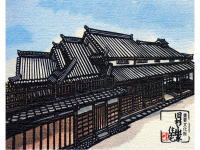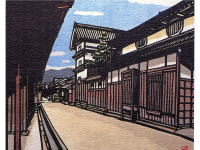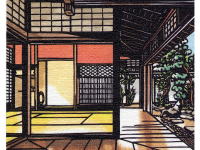富田林寺内町の探訪
I'm glad to intorduce an old town, Jinaimachi, Tondabayashi, Osaka, Japan as a national historic district and heritage site.
It takes 30 minutes from Osaka city to Tondabayashi station by Kintetsu railways. A 10-minutes walk will take you to the historic town.
ギャラリー
Koushouji Betsuin Temple, National important cultural property
| 【Tourist guide to Jinaimachi town, Tondabayashi, a histric district and heritage site of Japan, Koushouji BetsuinTemple Page 2/5】 | |
| Koushouji Betsuin Temple is a temple of Jodo Shinshu School (Ikkoushuu
School), which became the center of the development and establishment of
Jinaimachi town in Tondabayashi . It has been popular as Gobo-san (Tondabayashi
Gobo) among the local residents. In May 2014, to the Minister of Education, Culture, Sports, Science and Technology, Council for Cultural Affairs submitted a report in order to designate as an important cultural property of the country the 6 buildings of Koushouji Beysuin Temple such as its main hall, dedicated meeting room for royal family, bell tower, drum tower, temple gate and Onarimon gate. Koushouji Betsuin Temple has been highly praised because the main hall is the oldest building in Osaka Prefecture among the similar main halls of the Jodo Shinshu Sect., because arrangement of temple buildings of old age has been well stored and maintained and the temple has been the core of Tondabayashi Jinaimachi town which has been solely selected as an Important National Historic Preservation District for Traditional Properties in Group in Osaka Prefecture. |
|
| Main Hall The main hall of the temple is divided into an outer chamber and inner chamber by sliding doors on the paper surface of which elaborate painting works were drawn by Kano Juseki Hidenobu, a Kano school painter purveying to the Tokugawa Shogunate in the Edo period. The works are called the "Sho Chiku Bai" (an auspicious combination of pine tree, bamboo and plum tree). Kano Juseki Hidenobu. is a painter depicting the famous pine trees at the great corridor of the main ward of Edo-jo castle, literally called a corridor of pine trees, where a well-known affair of sword fight happened. |
|
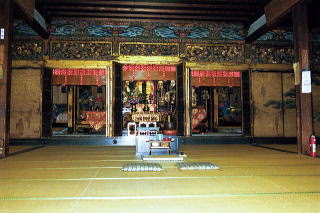 The main hall The outer chamber and the inner chamber |
Built as a mission in Tondabayashi, the outer chamber is larger than the
inner chamber. Buddhist statues and images are enshrined in the inner chamber as follows. ① Standing statue of Amitabha (said to have been created in the Kamakura period.) ② Image of Shinran Shonin ③ Image of the founder, Shoushuu Shonin ④ Image of Hanazono Sesshin, Honjyaku Shonin |
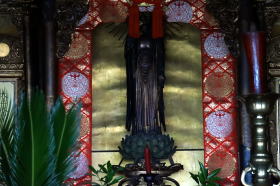 Standing statue of Amitabha (center) |
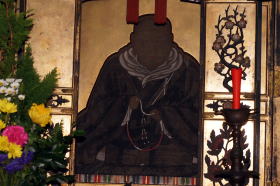 Image of Shinran Shonin(right) |
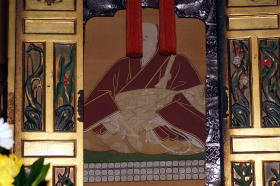 Image of the founder, Shoushuu Shonin(left back) |
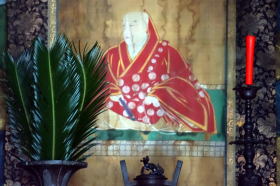 Image of Hanazono Sesshin, Honjyaku Shonin(left) |
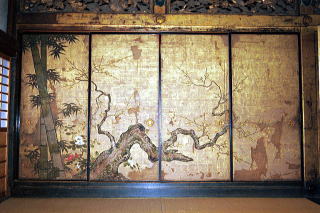 "Pine tree, bamboo and plum tree" painting works by Kano Juseki Hidenobu |
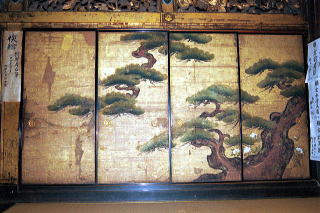 "Pine tree, bamboo and plum tree" painting works by Kano Juseki Hidenobu |
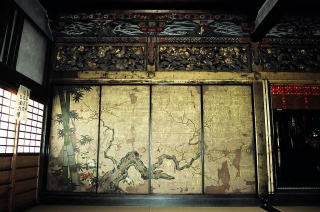 "Pine tree, bamboo and plum tree" painting works by Kano Juseki Hidenobu and elaborate sculupture of transom |
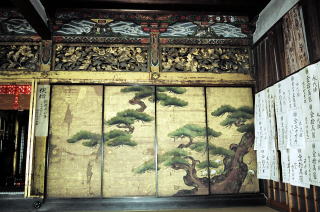 "Pine tree, bamboo and plum tree" painting works by Kano Juseki Hidenobu and elaborate sculupture of transom |
| The twenty-four paragons of filial piety In the interior of the Koushouji Betsuin main hall, the structure called Kaerumata at the top of the beam of the front, that looks like stretched frog's legs, can be seen as decorative sculptures colored in vivid which show seven episodes. The seven sculpture work are derived from the twenty-four paragons of filial piety in old China selected by Guo Jujing (Kaku kyo Kei in Japanese) during the Yuan Dynasty. Temples also used to be a primary educational institutions called Terakoya in the Edo era in Japan and by showing a sculpture, the teachings of Confucianism was inculculated to children. |
|
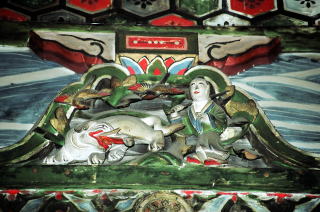 Dashun (Great Shun) The first when viewed from the right hand toward the front |
Dashun (Great Shun) He was one of the legendary Three Sovereigns and Five Emperors who were a group of mythological rulers and deities from ancient china. His mother died when young. He suffered from any kind of abuse given by his blind, stubborn father, cruel his stepmother and arrogant, his lazy, younger brother. He was nearly killed many times. However, Shun would never bear no grudge and was in contact with charity and obedience, and was always unchanged. The Heaven would never desert such Shun. When he went to a rice field, an elephant appeared and plowed the field, and then birds came and helped taking the grass of the field. The field was known throughout the country as it had become bigger and bigger with the help of villagers and animals. By praising Shun, Emperor Yao at the time let his daughter marry him and handed over emperorship to Shun. Shun became the emperor of the country of Yu and people called him Dashun (Great Shun). |
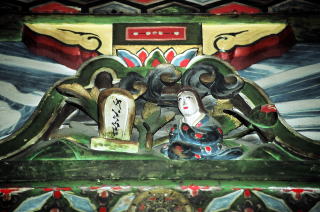 Wang Pou,the 16th episode The second when viewed from the right hand toward the front |
Wang Pou Wang Yi, Father of Wang Pou in the times of Jin, was executed by the anger of the emperor of the time though he was innocent. Wang Pou bore a grudge against this and he sat down, turning his back on the direction where the emperor was. He worshiped in front of the father’s grave, clung to the tree of the oak nearby, and continued to cry, and the tree of the oak died. When his mother died, he went to the mother’s grave during thunder storms, said to her "Please don’t worry" and watched it because she had feared lightning while alive. |
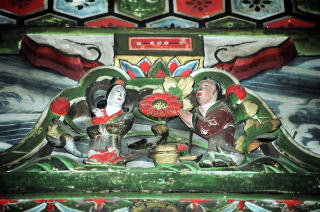 Guo Ju, The third when viewed from the right hand toward the front |
Guo Ju The times of the Han dynasty. Guo Ju in Henei supported his wife and mother while the household was extremely poor. As he saw his old grandmother give her meal to a three-year old child, he discussed the situation with his wife, saying “We cannot feed our mother. I finally resolved to part with his child. We may have more children When Guo Ju, shedding tears, was digging the grave, they discovered a golden pot with a written message that the pot is given to filial piety of Guo Ju. Nobody must steal it.” Guo Ju and his wife thanked the heaven, took the child home, and they did devoted themselves to their mother further. |
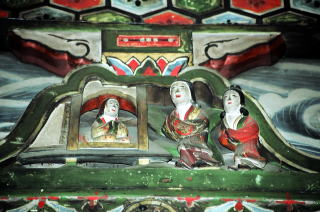 Ding Lan, the 12th episode The fourth when viewed from the right hand toward the front |
Ding Lan When his wife burn the wooden statue on purpose, it got swollen, pyemia |
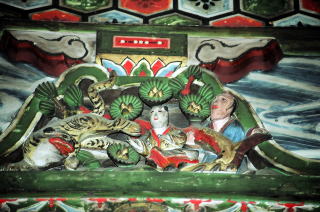 Yang Xiang The fifth when viewed from the right hand toward the front |
Yang Xiang Yang Xiang, a fourteen-year-old son living in the era of Jin, together with her father, went in a recess of mountain, on the way to the rice field. A tiger suddenly appeared and attacked. Yang Xiang prayed to the Heaven, "Do not let the tiger eat my father. Please let the tiger eat myself." Then, the tiger turned tail and left quietly. Father and son were able to safely descend. The villagers rumored that a miracle happened as the Heaven knows the filial piety. |
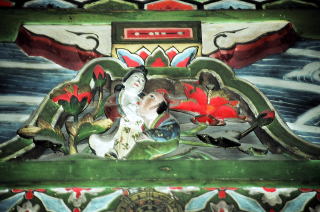 Tang Furen, the 23rd episode The sixth when viewed from the right hand toward the front |
Tang Furen In the times of Tang Dynasty, Tang Furen, a wife of regional military governor
named Cui Shan Nan, who lives in Bo Ling, devoted to Chan Zhang Sun Furen,
her mother-in-law. All the people praised her as there has never been such a filial bride to mother-in-law as Tan Furen in both the past and the present. Her husband, Cui Shan Nan succeeded in life and became a high official. |
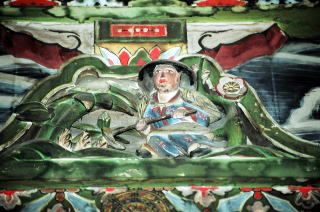 Meng Zong, the 20th episode) The seventh when viewed from the right hand toward the front |
Meng Zong The mother of Meng Zong wants to eat bamboo shoots in winter, when she
becomes old and gets ill. Meng Zong walked around in bamboo groves in the
snow and prayed. Suddenlythe earth broke, bamboo shoots appeared. She gets
healthy when he serves soup of bamboo shoots to her and lives a long life.
Meng Zong succeeded in life and became a high officer to govern people
and land. The Heaven sympathize the depth of filial piety. |
| 【Tourist guide to Jinaimachi town, Tondabayashi, a histric district and heritage site of Japan, Koushouji BetsuinTemple Page 1/5】 | |
| 【Tourist guide to Jinaimachi town, Tondabayashi, a histric district and heritage site of Japan, Koushouji BetsuinTemple Page 2/5】 | |
| 【Tourist guide to Jinaimachi town, Tondabayashi, a histric district and heritage site of Japan, Koushouji BetsuinTemple Page 3/5】 | |
| 【Tourist guide to Jinaimachi town, Tondabayashi, a histric district and heritage site of Japan, Koushouji BetsuinTemple Page 4/5】 | |
| 【Tourist guide to Jinaimachi town, Tondabayashi, a histric district and heritage site of Japan, Koushouji BetsuinTemple Page 5/5】 | |
Information
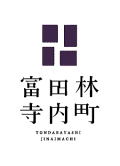
Open to the public
Denomination
Shin Shuu School Koushouji Sect.
Location
Jyounomon suji street and Sakai machi street (Sakai suji street)
During the Ouei period (1394-1412 years) , the incipient temple was opened
in Ebitani
Features of the building
The temple gate looks toward the east and the Jyounomon-suji street. Those buildings such as the bell tower, the drum tower, the main hall,
the reception hall and priest's quarters are set up and arranged. The main
gate has refined style and it became clear in a recent investigation that
the gate was further relocated from Koushouji temple in Kyoto, which was
originally said to be dismantled and reconstructed from one of the gates
at Fushimi castle in Kyoto.
It has a Yakui-mon style structure. The gate was re-relocated from the
north gate of Koushouji temple in Kyoto, that had been handed down from
one of the gates of Fushimi Castle. The scale of the gate is larger than
average one of temple and it is said to ensure a height that warriors could
pass across on the horse. The main street of the town in front of the gate
is called Jyounomon-suji street, which was literally named after the castle
gate.
Amebuta-kawara
Decorative tile that lies at the corner of the roof, covering the junction
of the roof tiles.. The decoration of animals can be often seen. It is
also called Tomebuta Kawara.
Main Hall(Important Cultural Property)
The main hall is the oldest building among those of the Jodo Shinshu sect.
temples in Osaka Prefecture. Main hall was used as a small private school
in the Edo era and it is the predecessor of Tondabayashi Elementary School
today. Before World War II, the elementary students visited the temple
to celebrate the foundation festival of the temple and candy was handed
out to children on the occasion, while many stalls were open on the street
in front of the temple. During World War II, there was a record that the
temple accepted students of Hirano Elementary School in Osaka to live in
the temple as school evacuation of the war fire.
Memorial monument of Shoushuu Shounin
Next to the main hall, there is a memorial monument of Shoushuu Shounin,
who was the 16th head priest of Koushouji temple in Kyoto and the founder of Koushouji
Betsuin temple (Tondabayashi Gobo). Built in 1896. Given the history is
that Tondabayashi Jinaimachi town was established around Koushouji Betsuin
Temple and it has prospered as an economic center of Minami-Kawachi region
after that, Shoushuu Shounin could be called as father of exploitation
of Tondabayashi.
Onarimon (Important Cultural Property)
The small annexed gate next to the temple gate. Chrysanthemum crest has
been decorated in Onarimon (gate for Imperial envoy). The gate was relocated in the late Edo period. It is a highly decorative
gate even small in scale and the building age dates back to the mid-Edo
period, but unknown where it had been originally located. It is believed
to have been relocated to the current location at the same time when main
temple gate was relocated from Koushouji Temple in Kyoto in 1857.
Though there is the record Crown Prince Hirohito (the Showa Emperor) visited
ruins of Akasaka Castle in 1917, the birthplace of Kusunoki Msashige, but
it is unclear whether he also visited Koushouji Betsuin Temple on this
occasion.
Built in 1810, the building was located in the southeast corner of the
precinct. The tower of tetrahedral has no walls and the bell have been
suspended in the center. Bell has been rung on such occasions as Spring
Festival (Foundation Festival to celebrate Shoushuu Shounin) , Autumn Festival (Gratitude Lecture to celebrate Shinran
Shounin) and the bell on New Year's Eve., too.
Drum Tower (Important Cultural Property)
Built in the late 18th century, older than the bell tower, it has been
relocated to the northeast corner of the precincts in 1810. It is a two-story
storehouse building with thick earthen walls. The windows of the second
floor is characterized as Katomado style.
The site-seeing map available in English
Please stop by to the Tourist Information Cetnter or Jinaimachi Visitor
Center.
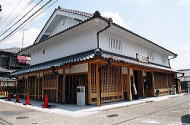
Visitor Center
(Jinaimachi Kouryuukan,
Town Community Center)
Address
9-29, Tondabayashi-cho, Tondabayashi city, Osaka, 584-0033, Japan
TEL.+81-(0)721-26-0110
FAX.+81-(0)721-26-0110
open 10a.m. until 5 p.m.
closed on Monday
Restrooms
Available at Jinaimachi Visitor Center (Jinaimachi Kouryuukan), Jinaimachi
Center and Jinaimachi Tenbou Hiroba (Viewing Terrace)
Visitor Parking
Road width is very narrow in Jinaimachi town. If traveling by car, please
use Tondabayashi Municipal east parking newly opened in February 2014 (Toll
parking).
You can park the minibus for groups and passenger cars for general use.
Only one parking lot available for minibus, you must book it in advance
with Tondabayashi City Hall. A 15-minute walk to the Jinaimachi Visitor
Center and 5 minute walk up to the former Sugiyama family house, an important
national cultural property.
You will note that the large tourist bus for groups is requested to be
parked at the Tondabayashi City Hall No. 2 parking lot alongside the old
Route 170 (It must be booked in advance to City Hall). 20-minute walk to the Jinaimachi
Visitor Center and 10 minute walk up to the former Sugiyama family house,
an important national cultural property. Thank you in advance for your
kind cooperation.
